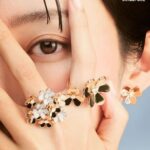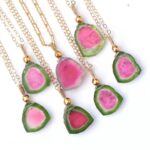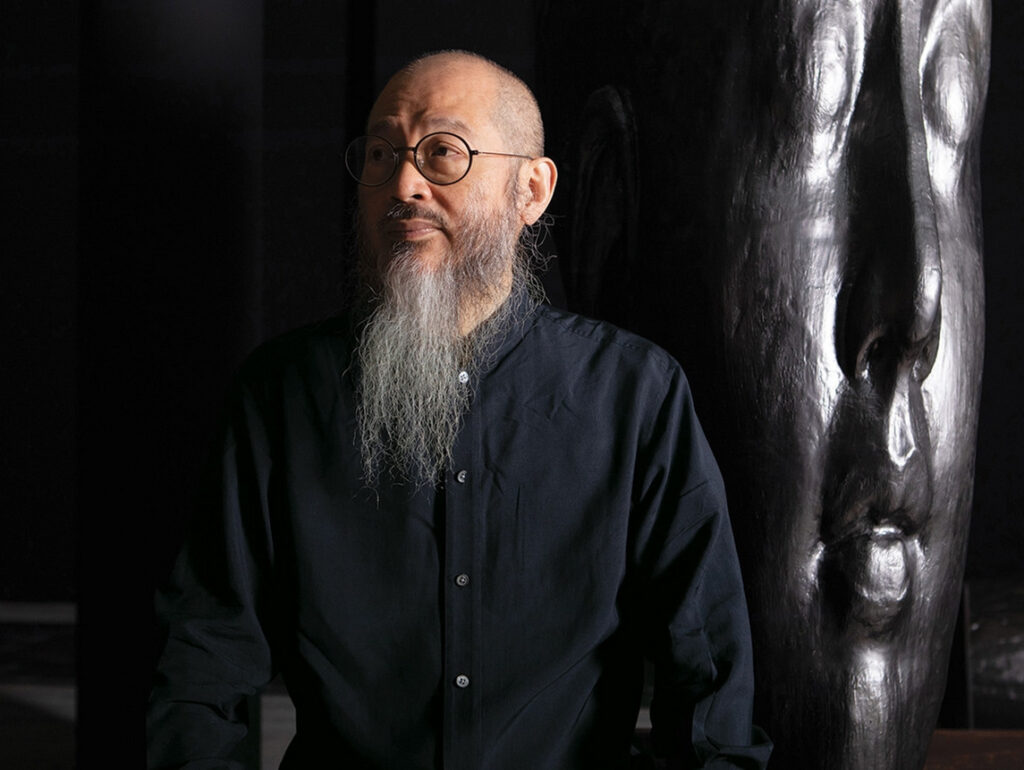
Over the past few decades, Wallace Chan has garnered numerous accolades on the world stage. He was the first Chinese jewelry artist invited to exhibit at the Biennale des Antiquaires in Paris and the TEFAF European Fine Art and Antiques Fair.
He was also the first Chinese jewelry artist to have his work included in the permanent collection of the British Museum. In 1992, the German Gem Museum held a solo exhibition for Chan, marking the first time an Asian artist had been featured there.
Western media hailed him as the “Asian carving genius.” In 1987, Chan won an international design award for his “Goddess of Mercy” piece, created using his patented “Wallace Cut” illusory carving technique.
Industry insiders never hesitate to praise Chan: “In the Chinese jewelry world, he is at the pinnacle, without peer.”
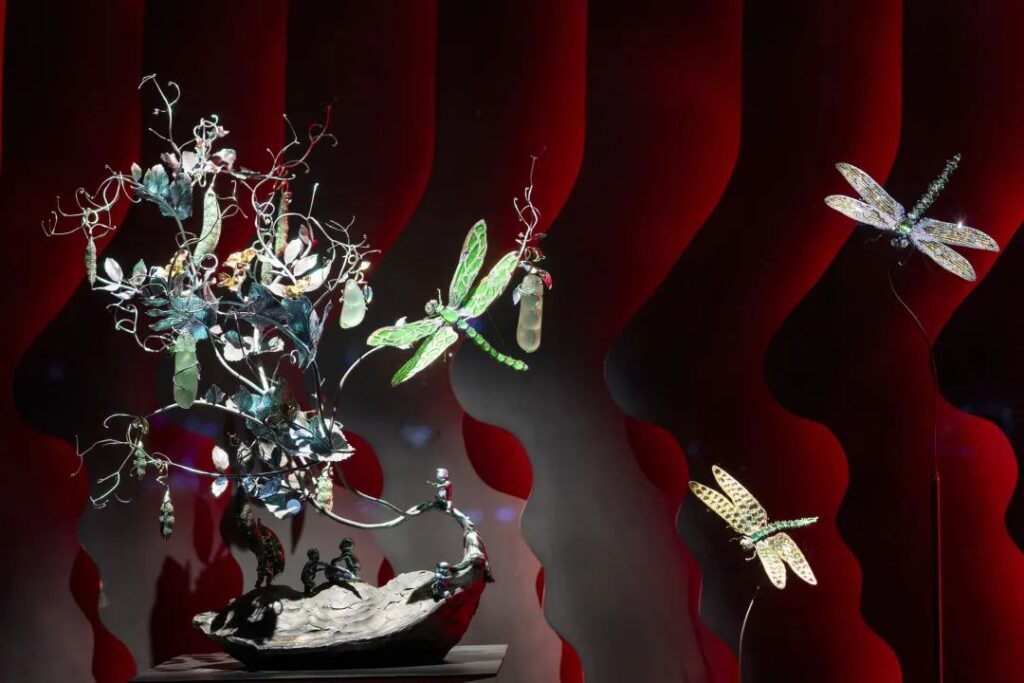
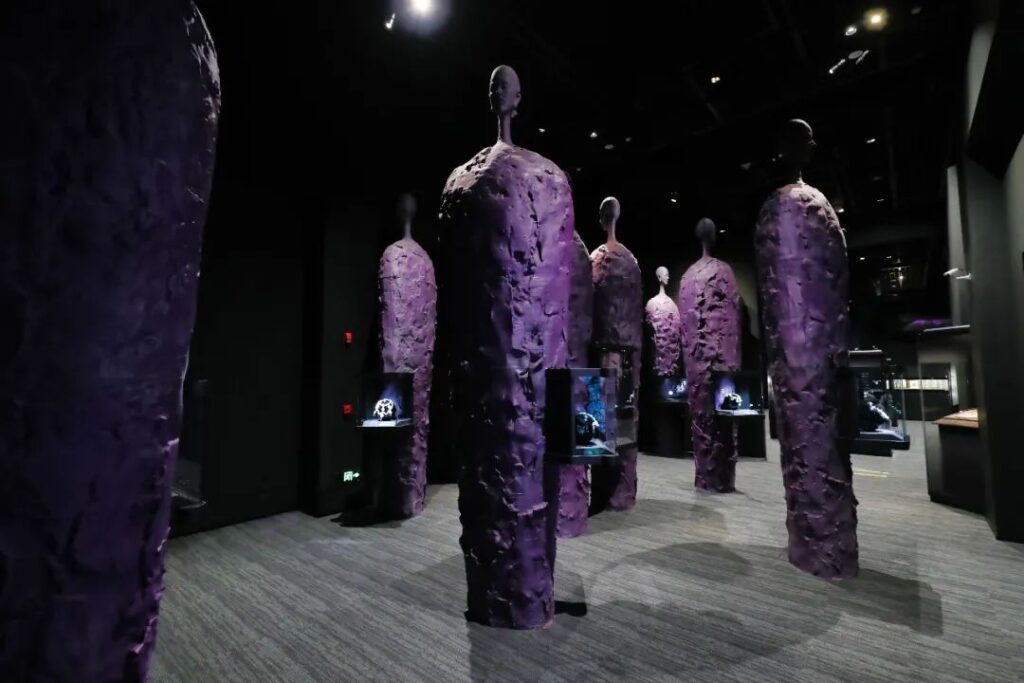
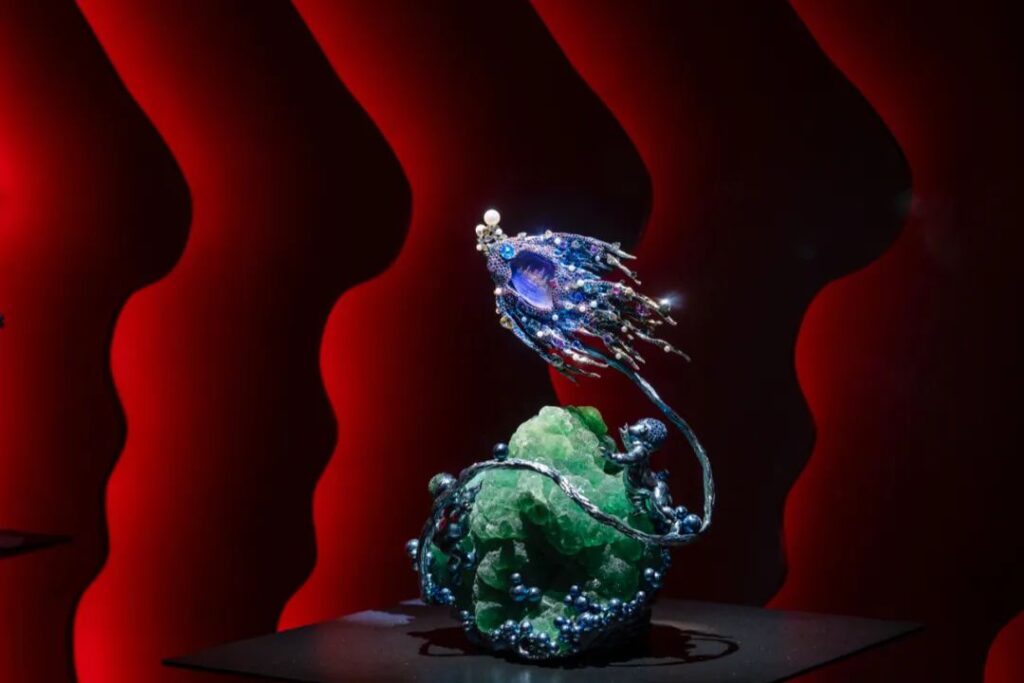
Now, at 68 years old, Chan has returned to his homeland with honor, becoming the first contemporary artist to hold a solo exhibition at the East Hall of the Shanghai Museum. His largest jewelry exhibition to date, “A Dialogue Through Time,” is currently dazzling visitors in Shanghai.
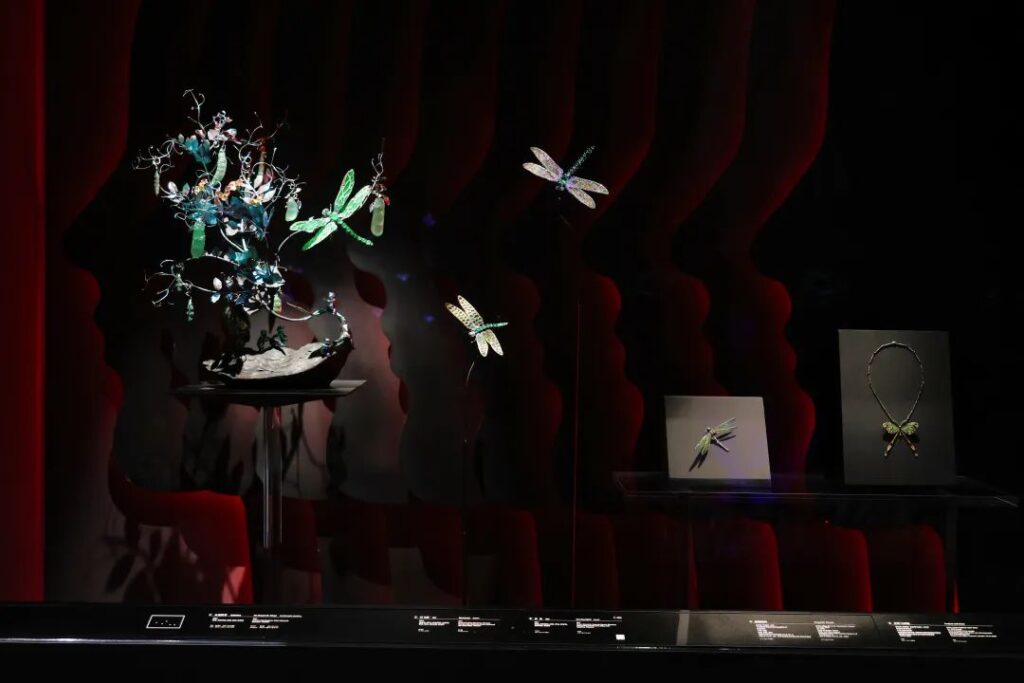
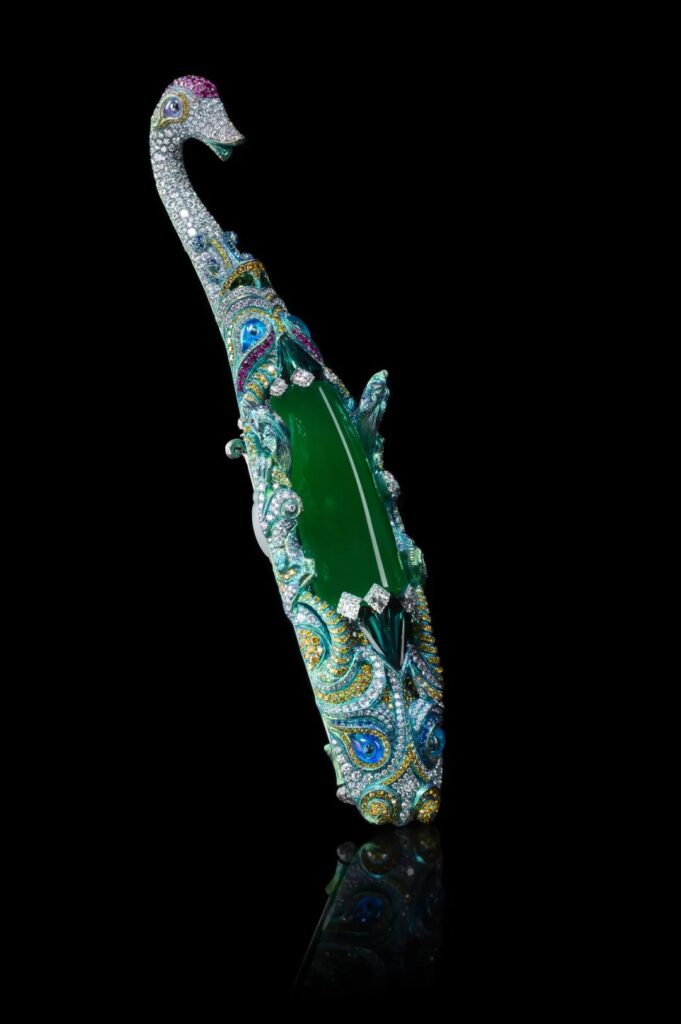
Chan spent a year and a half preparing for this exhibition. “But if I were to count carefully, I’ve been preparing for 50 years, one cut at a time,” he said at the pre-exhibition press conference. “In 1973, at the age of 16, I encountered my first stone. That piece of malachite was like a magical catalyst, drawing me into a world of color, texture, and crystalline transformation.”
Little did he know that this first cut would lead to a lifelong relationship with stones.
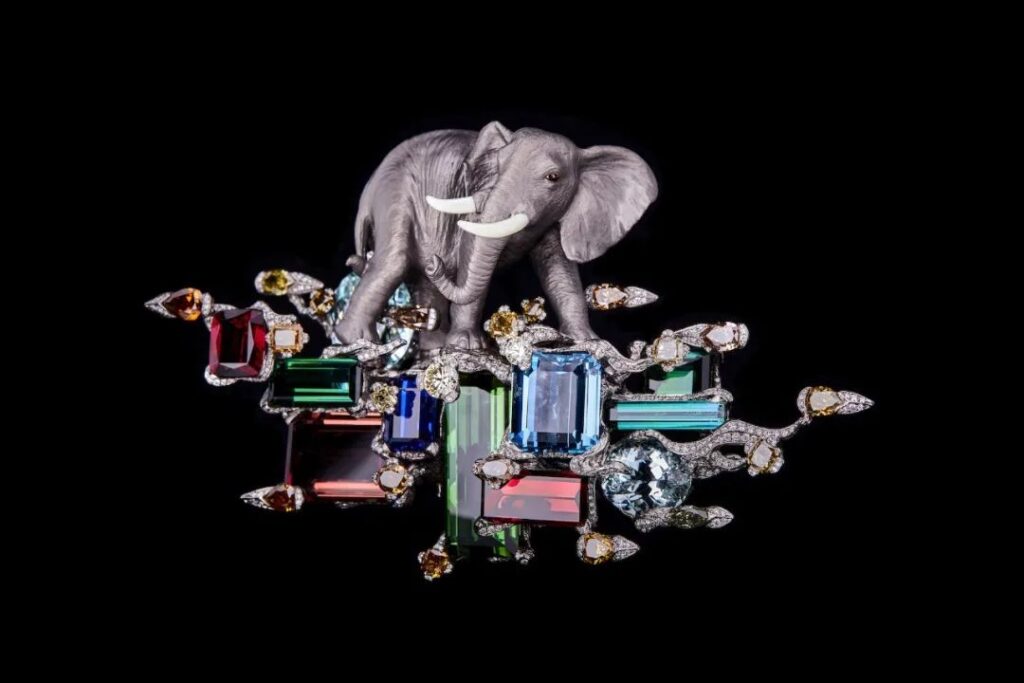
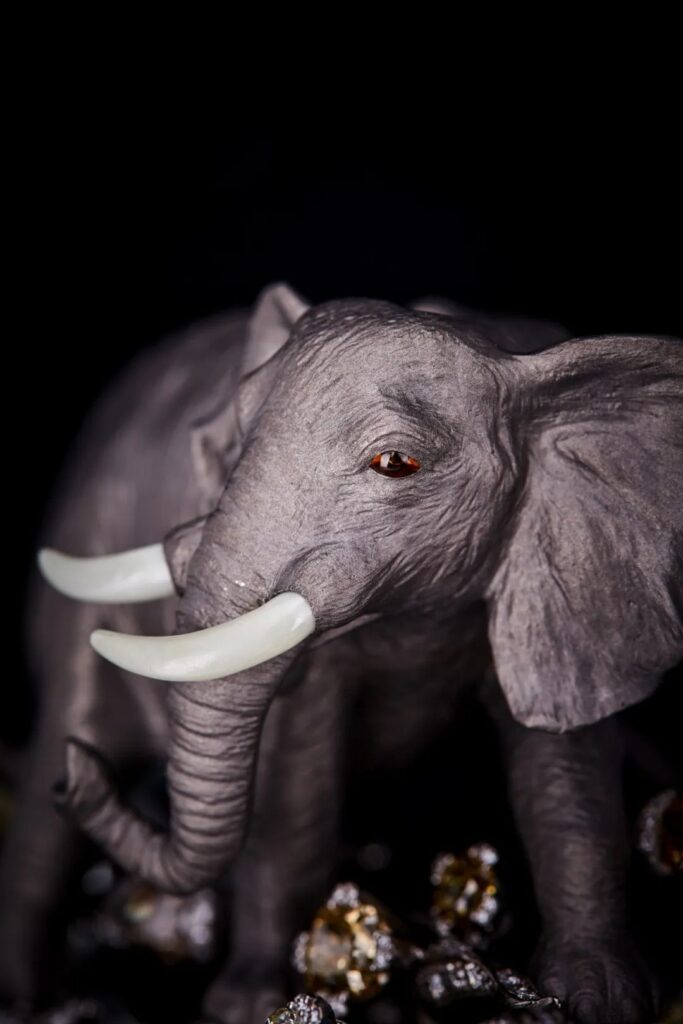
Green tourmaline, red tourmaline, sapphire, tanzanite
Colored diamonds, diamonds, obsidian, yellow corundum
Pearls, Wallace Chan Porcelain, titanium
Chan once bought an unremarkable stone, ridiculed by those around him for his foolishness. However, when he cut it open, it revealed the gem he had envisioned. “The most unassuming stones on the surface often hold the most beautiful interiors. Unknown beauty needs to be created.”
Creation is the superpower bestowed upon Chan by heaven.
When he lacked tools, he developed them; when his ideas seemed impossible to realize, he invented new techniques – the “Wallace Cut,” the “Wallace Chan Porcelain” (five times harder than steel), the application of titanium in jewelry making, patented techniques for cutting and polishing jade, the “inner mortise and tenon inlay method” inspired by Ming Dynasty furniture, and the “Vacuity-Solid” technique.
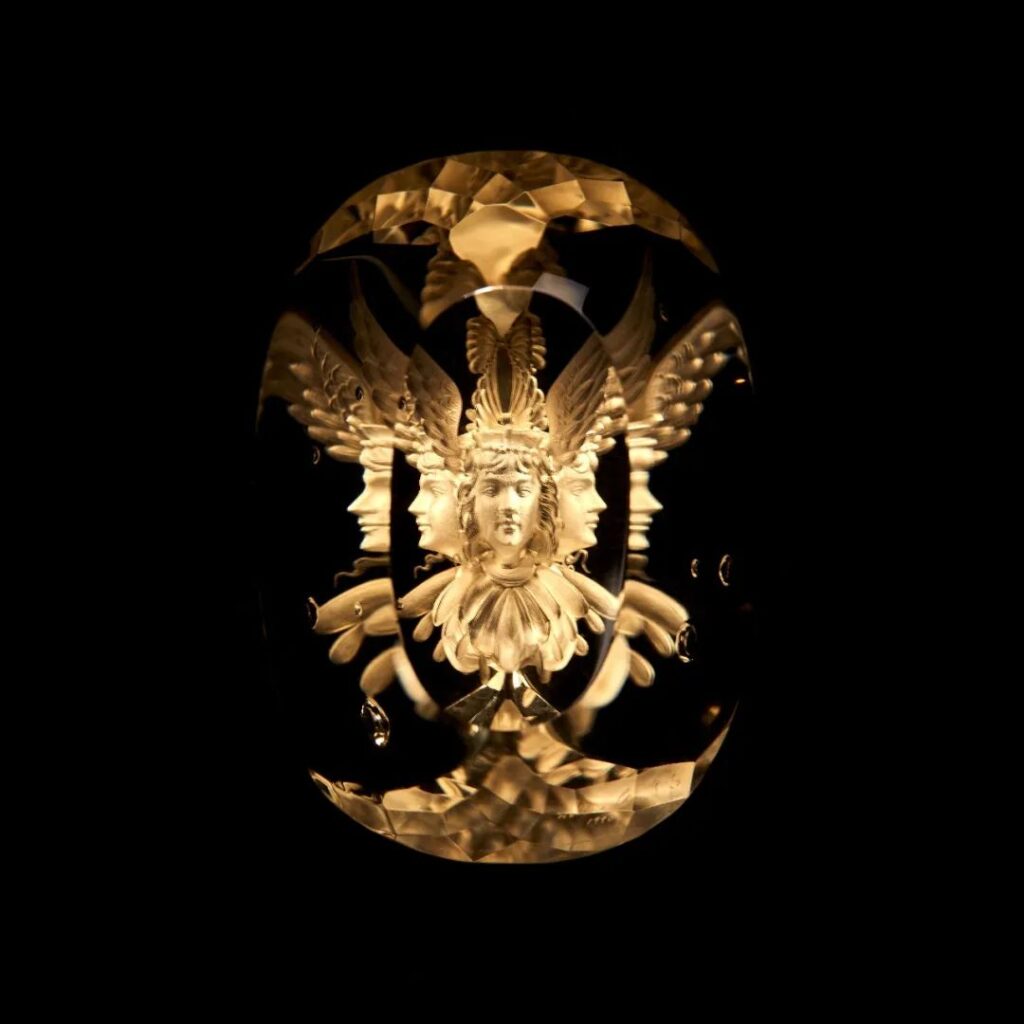
Invented by Wallace Chan in 1987
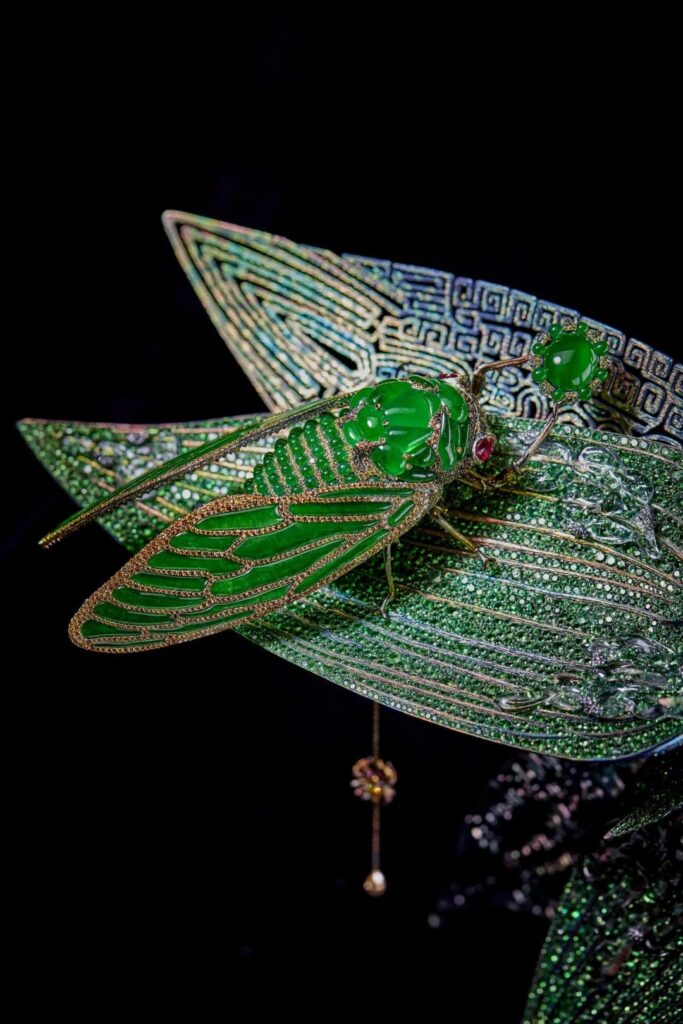
Imperial jadeite, imperial jadeite beads, lavender jadeite, jadeite, ruby,
Colored diamonds, colored corundum, tsavorite, crystal, 18K white gold, titanium
Created by Wallace Chan
These innovative techniques, born from traditional carving skills, bridge the disciplines of art, physics, chemistry, and metallurgy. For Chan, who never received formal academic education, this is nothing short of legendary. However, what has made Chan who he is today is not training from academic knowledge, but his innate intuition and curiosity, his sensitivity to the touch of materials and to sound.
His apprenticeship background provided him with the solid craftsmanship of a traditional artisan: intaglio, relief, line carving, bas-relief, inner carving, inlaying, polishing… Driven by his thirst for knowledge, he continuously studied and researched. Chan is a prime example of a self-taught artist.
“Constantly experimenting, constantly reflecting, constantly questioning the materials themselves,” Chan says. He had no teachers, but everything in the world became his teacher. “And then they become my classmates.”
This is why Chan is never afraid of imitation, because he has never repeated himself.
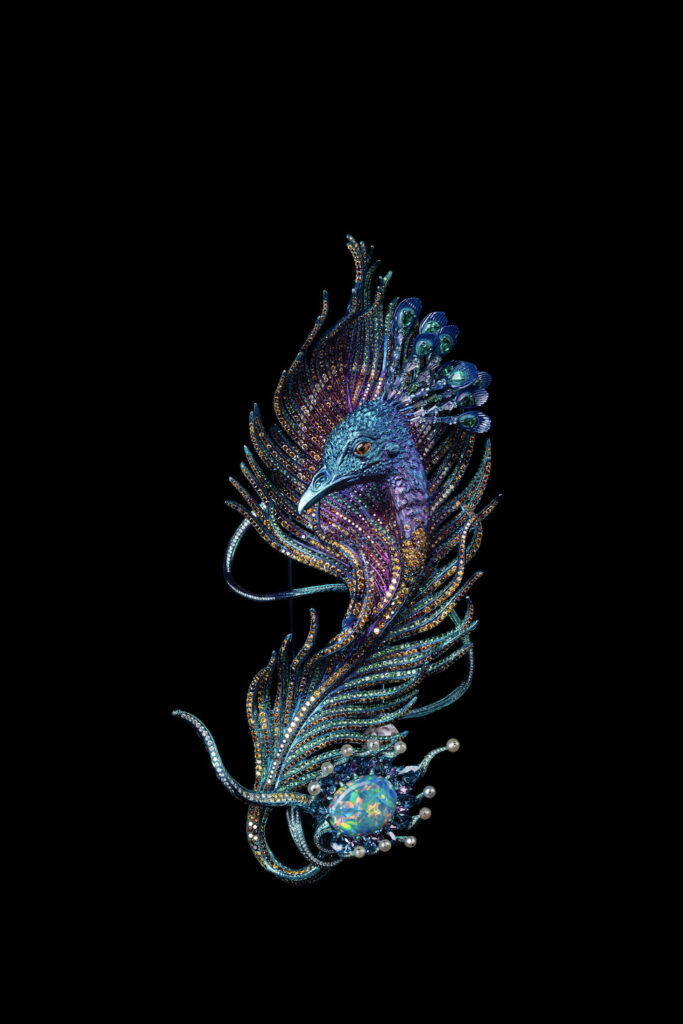
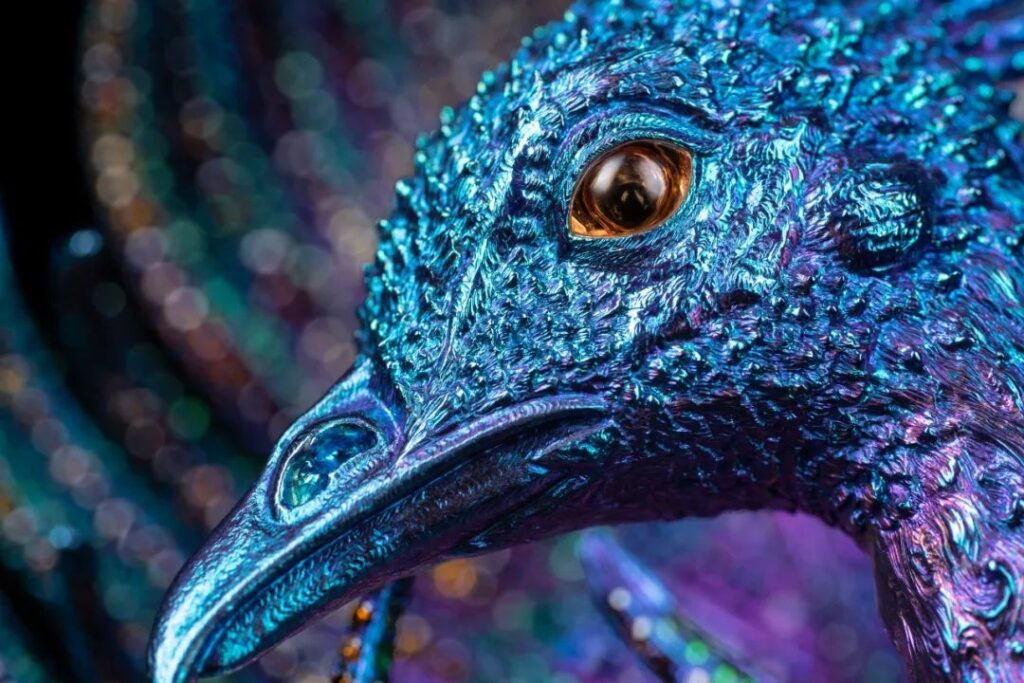
Black opal, padparadscha sapphire, pink sapphire, sapphire,
Emerald, South Sea pearl, tsavorite, sapphire, opal,
Crystal, lapis lazuli, pearl, yellow diamond, diamond, brown diamond, Wallace Chan Porcelain, titanium
Created by Wallace Chan
Titanium was another challenge Chan conquered in his creations. After eight years of dedicated research, he finally mastered this non-magnetic, non-toxic, human-friendly metal material – liquefying solid titanium to 90% and injecting it into high-temperature resistant molds containing ceramic components.
This may sound simple, but it’s an extremely challenging technique. According to Chan, “Titanium is an extremely proud material; it doesn’t easily accept change. Its melting point is 1700 degrees Celsius. Even the tools and molds used to sculpt it melt away before it does.”
Titanium also doesn’t accept dyeing or plating. It naturally displays a deep gray with a silvery luster, close to black but transparent and luminous, making it impossible to impose external colors on it. Titanium metal weighs only one-fifth of the same volume of gold, making it lightweight yet extremely stable, extending the possibilities of jewelry art. In 2007, Chan opened a new chapter in jewelry art creation with his “wearable sculpture art pieces.”
This unique technique also laid a solid technical foundation for Chan to step from the jewelry field into contemporary titanium sculpture.
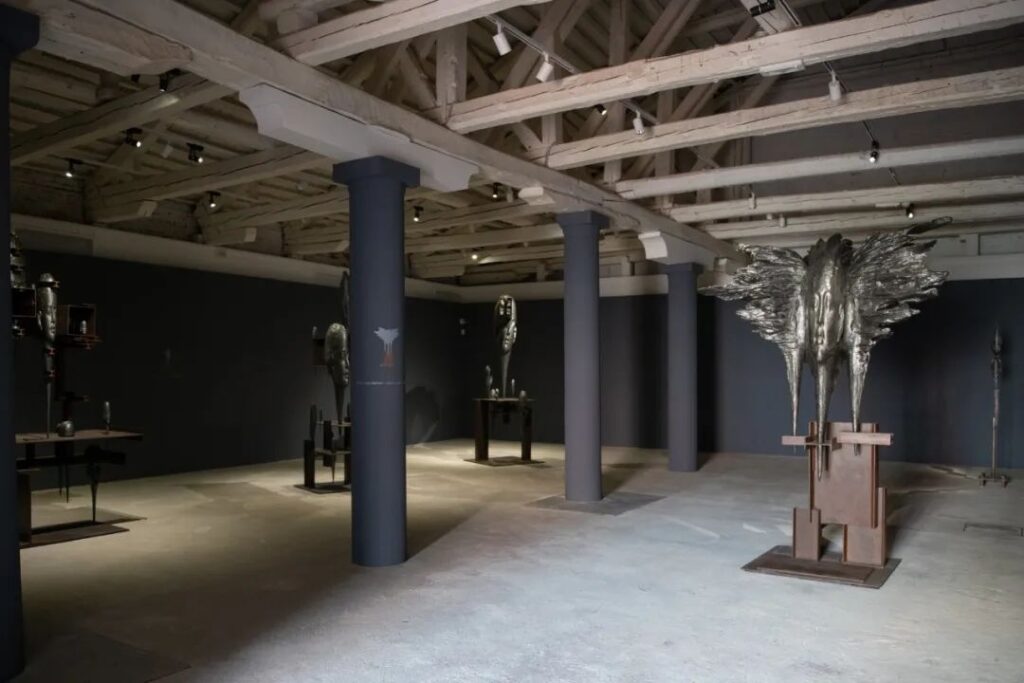
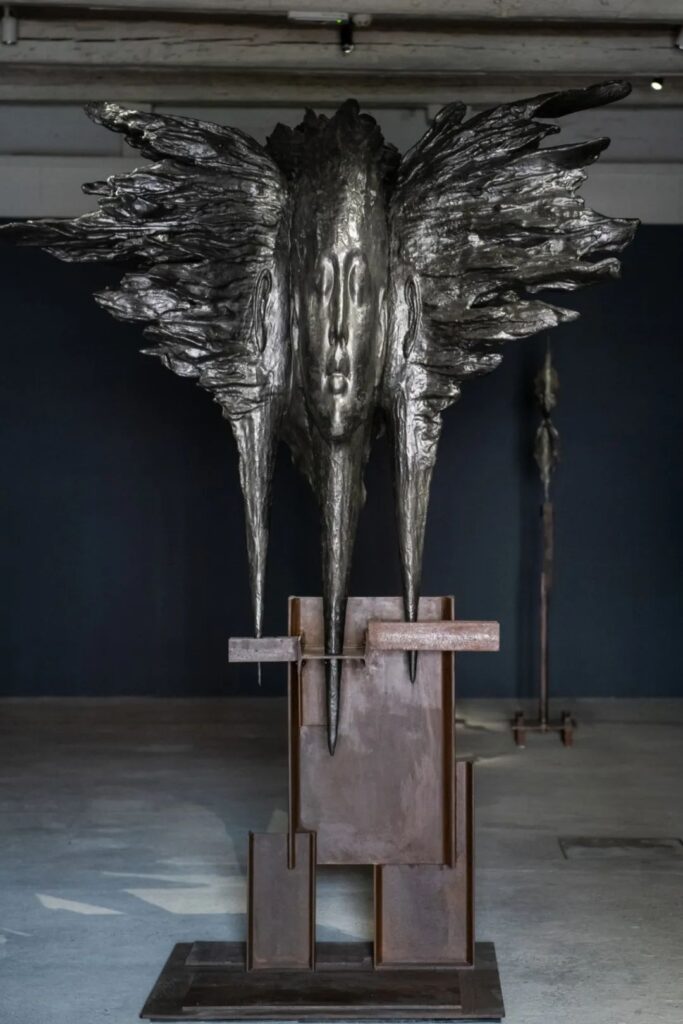
Fondaco Marcello, Venice, 2021,
Photo: Giacomo Cosua
In 2021, Chan held his first large-scale titanium sculpture exhibition as a contemporary artist in Venice, titled “TITANS: A dialogue between materials, space and time.” He juxtaposed iron, representing the past, with titanium, symbolizing the future, creating a tense binary opposition.
In 2022, Chan returned to the water city with a large-scale site-specific exhibition “TOTEM.” He presented a special installation composed of 10-meter titanium sculpture components. This work had previously appeared at ART021 but was disassembled and re-presented in the 15th-century Fondaco Marcello building in Venice. The disassembly signified rebirth after nirvana.
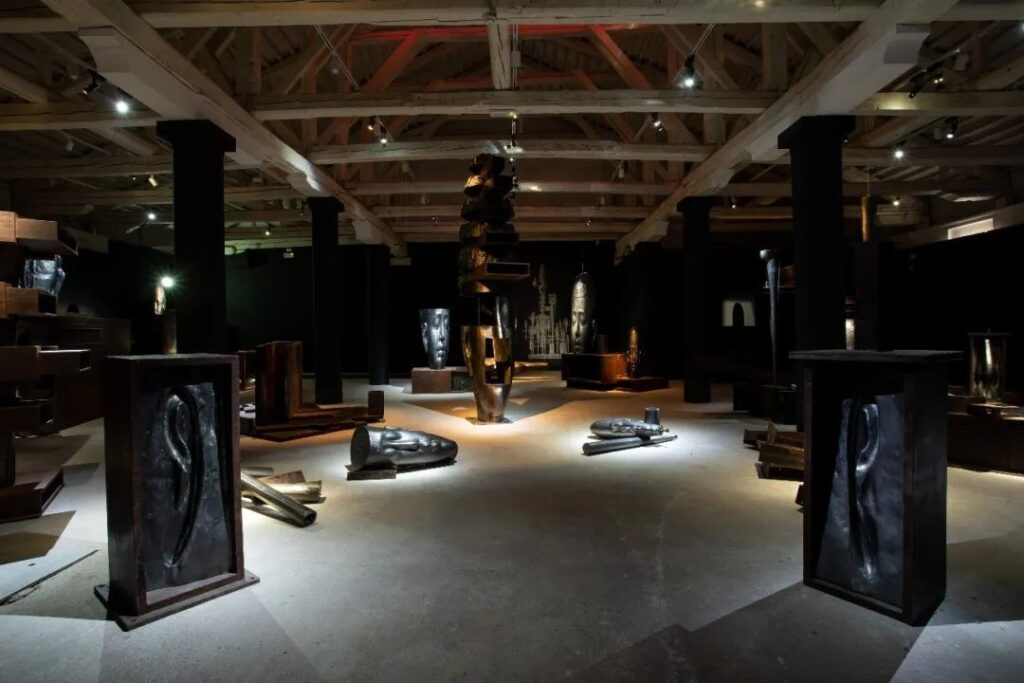
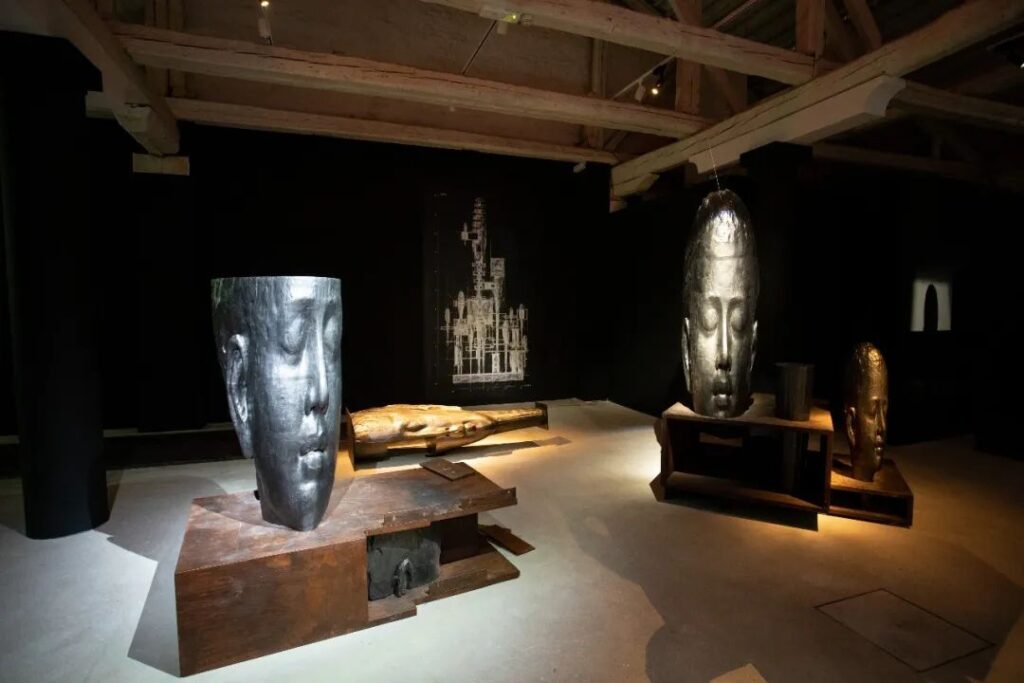
Fondaco Marcello, Venice, 2022
This April, Chan returned to Venice for the third time with his latest solo exhibition “TRANSCEND.” He said, “Venice is a stage one must stand on.”
In the Church of Santa Maria della Pietà, located in the heart of Venice, Chan’s titanium sculptures were suspended and arranged in sequence within the long, narrow chapel space. This 18th-century church has a long-standing connection with art, also known as “Vivaldi’s Church” due to the many world-renowned works composed there by musician Antonio Vivaldi.
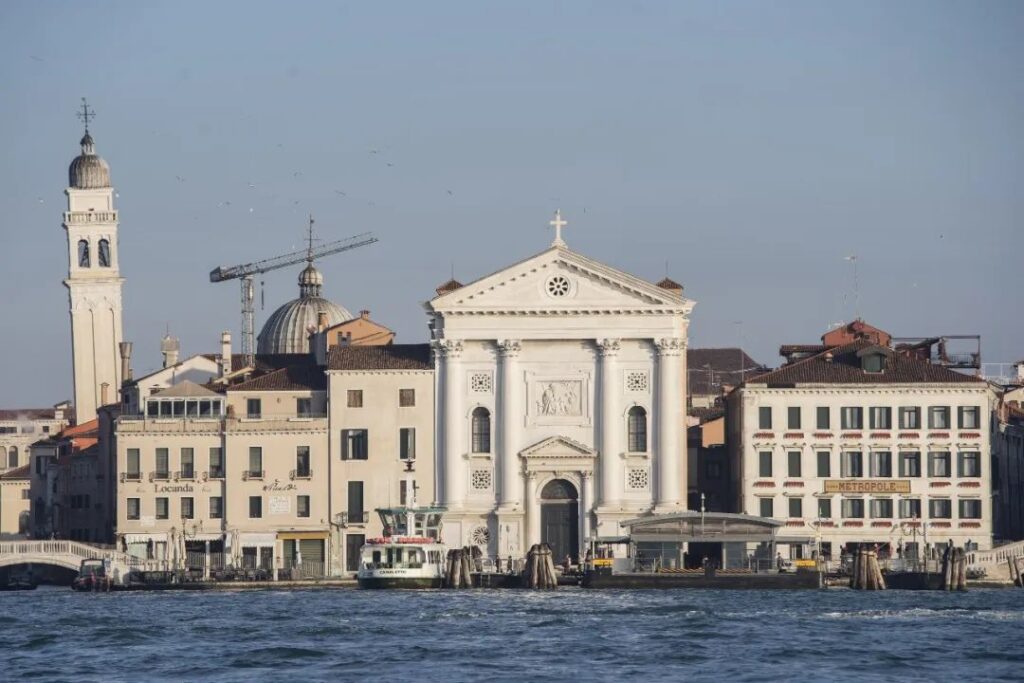
also known as “Vivaldi’s Church”,
located in the heart of Venice
The metallic faces, unnaturally elongated, are shrouded in dim light, with eyes and mouths seemingly exploding from within. The thin, straight noses and elongated, upright skulls create a force that compresses the interior, as if struggling to maintain a basic appearance.
Upon closer inspection, peaceful closed eyes slowly emerge, forming a stark contrast with the tense expressions. These faces lack clear internal skeletal support; they are more like a chaotic mass, a huge body of flesh, encased in a hard shell.
The original facial features have become windows, openings that allow the interior to manifest outwardly. When we turn to the back of the sculptures, the hollow and open treatment completely removes the conflict and tension, making the serene countenance more palpable.
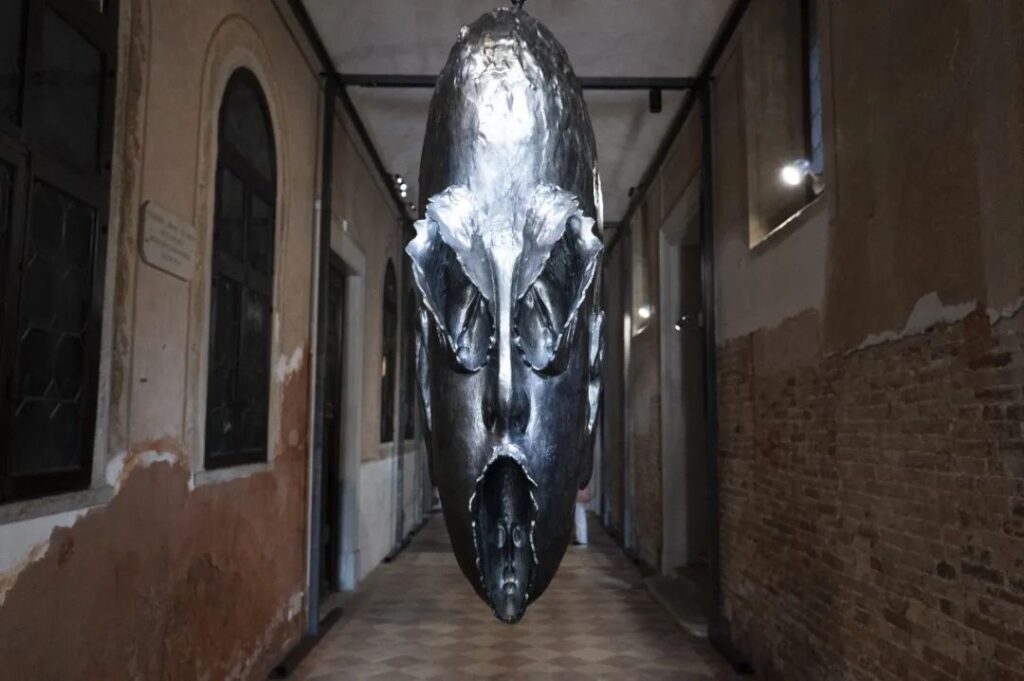
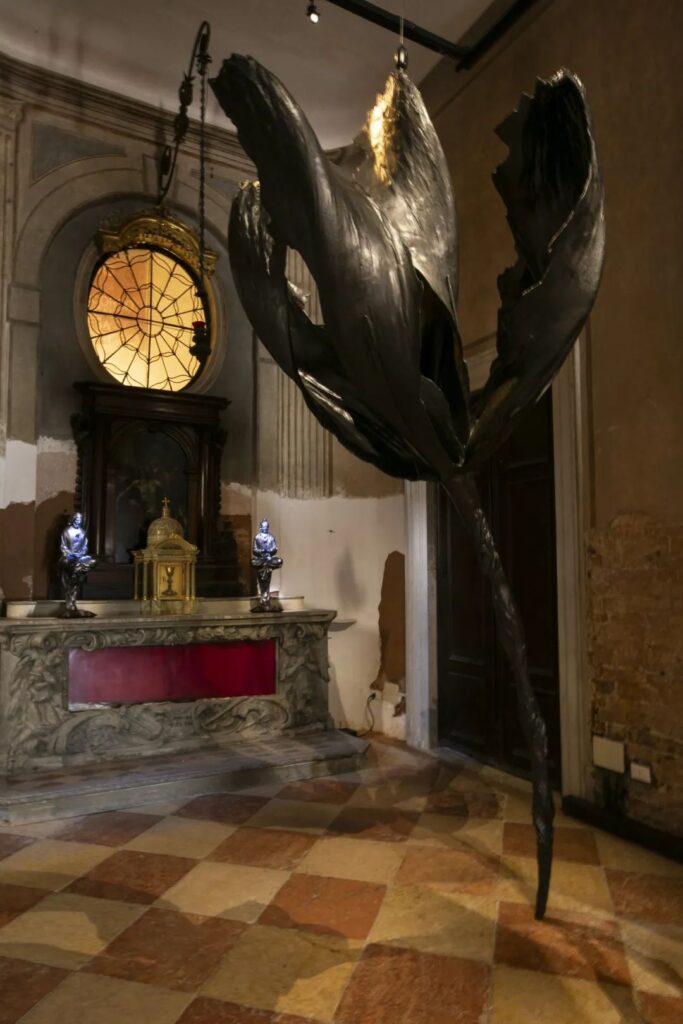
Santa Maria della Pietà, Venice, 2024 © Federico Sutera
Throughout his long creative career, faces have been Chan’s most familiar subject. From initial Guanyin and Buddha statues to later Christ and Madonna figures, to goddesses from Greek and Roman mythology… Chan has sculpted them countless times.
As he explains, “Because I carved many Buddha statues when I was young, serenity, peace, majesty, and sanctity became the ideal images in my heart, unrestricted by gender, age, race, and so on.” This explains why faces repeatedly appear in Chan’s sculptural works, even on tulip stems.
The tension of the sculptures and the introspection of the chapel, coupled with the ambient music of Brian Eno’s “I DORMIENTI,” create an atmosphere reminiscent of meditation in a cave on a steep cliff.
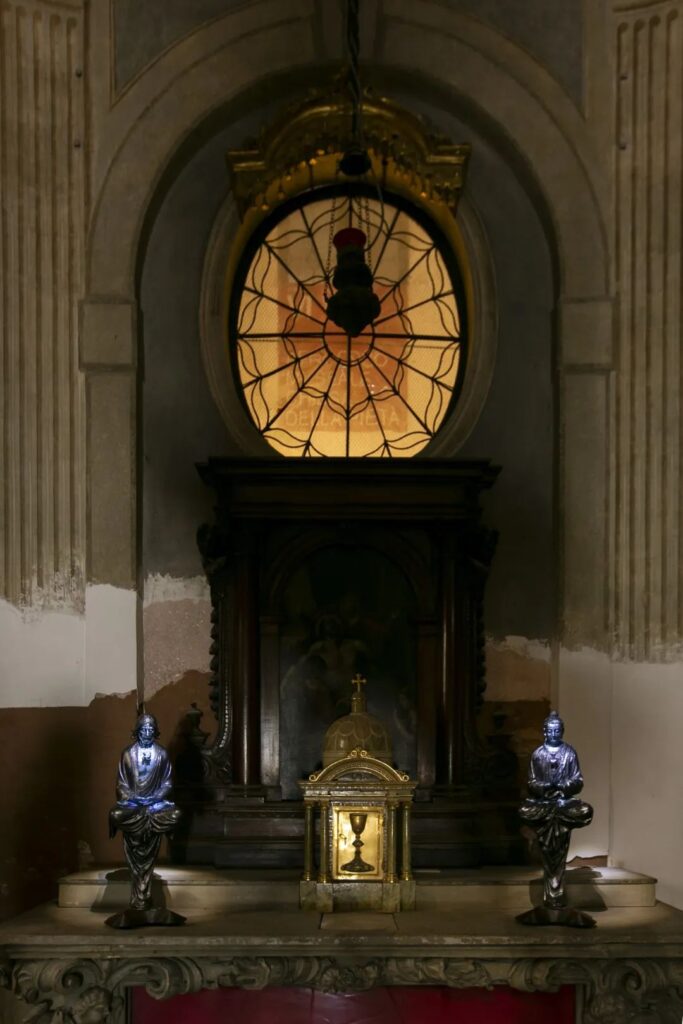
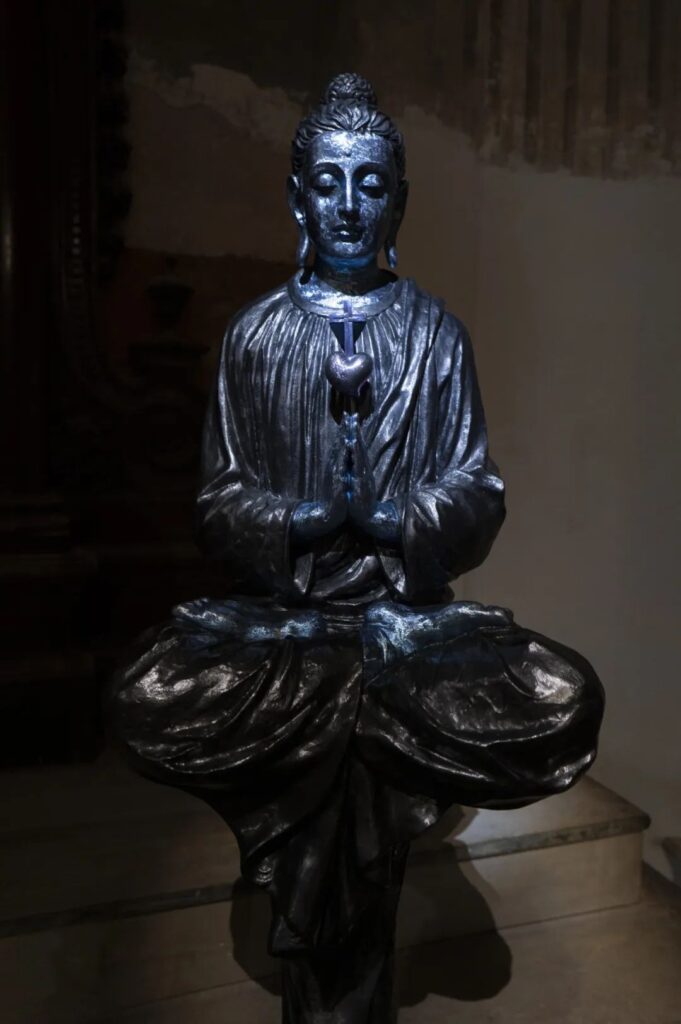
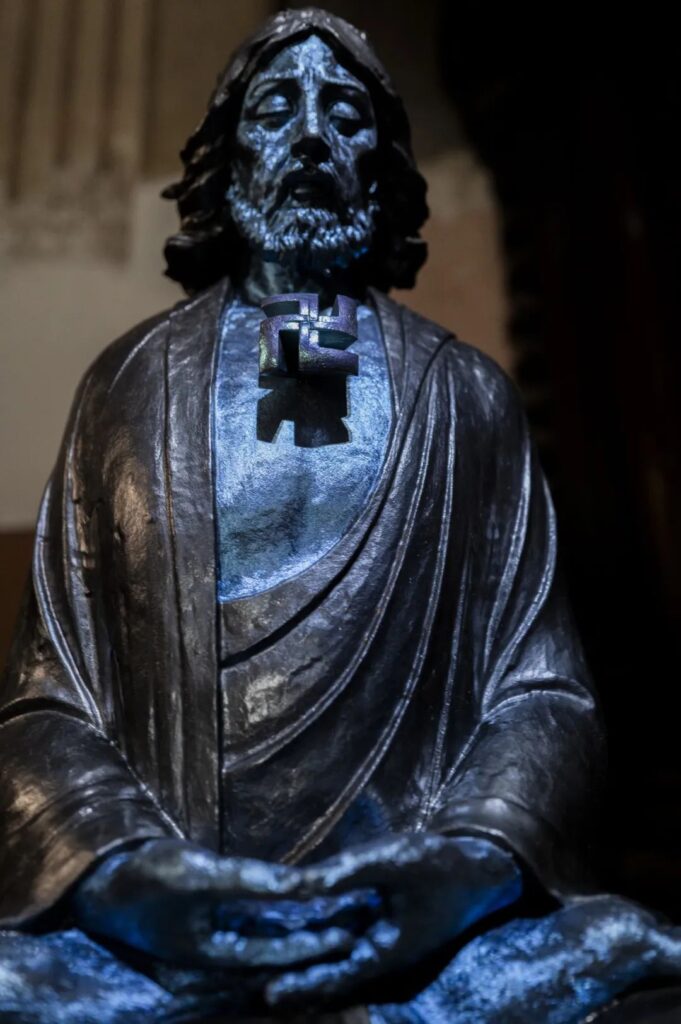
Santa Maria della Pietà, Venice, 2024 © Federico Sutera
At the deepest part of the chapel, two sculptures in typical Buddhist seated postures stand side by side on the altar. The head of the left sculpture is replaced with Christ’s, holding the meditation mudra, with the Buddhist swastika “卍” on the chest. The right Buddha head wears a cross on the chest, with hands in a Buddhist prayer pose that also resembles a Christian prayer gesture.
Chan places Eastern Buddha statues in a Western church, exchanges the identities of Christ and Buddha, making the impossible possible, transcending the boundaries of different cultures and religions. This is perhaps the ideal of Chan, who has ventured into the Western world – a spiritual state that transcends faith, race, age, and gender, eliminating all “self-attachment.”
As this creator, who belongs to no school and traverses between microscopic carving and macroscopic sculpture, says: “Through audacious creation, I have entered the world of reclusive practice.”
Hi Art (hereinafter referred to as Hi): What is the relationship between your previous jewelry creations and the series of sculptures recently exhibited in Venice?
Wallace Chan (hereinafter referred to as Chan): There is no outside to its greatness, no inside to its smallness. Even at the smallest scale, one can find the complexity and spirituality of the material world. The internal atomic and molecular structures of gemstones are isomorphic to the macroscopic world. So my jewelry creations can also be considered sculptures of the microscopic world.
Hi: For you, is the difference between jewelry and sculpture merely a matter of scale?
Chan: In fact, since I began learning gemstone carving in 1973, I have been creating sculptures simultaneously, never stopping. Creation, whether on a large or small scale, is interconnected, and creators should not be limited to any single art form or medium.
Jewelry creation involves gemology, optics, color theory, structure, metallurgy, ergonomics, cultural cognition, and more. My large-scale sculptures also incorporate jewelry-making techniques, such as elements of the “Wallace Cut” (Note: a 360-degree carving method pioneered by Wallace Chan in 1987).
For example, I spent eight years researching titanium for jewelry, and then applied this material to large-scale sculptures. Of course, technique is just a means; creation is still concept-driven. Whether microscopic or macroscopic, they are all ways for me to dialogue with matter and time.
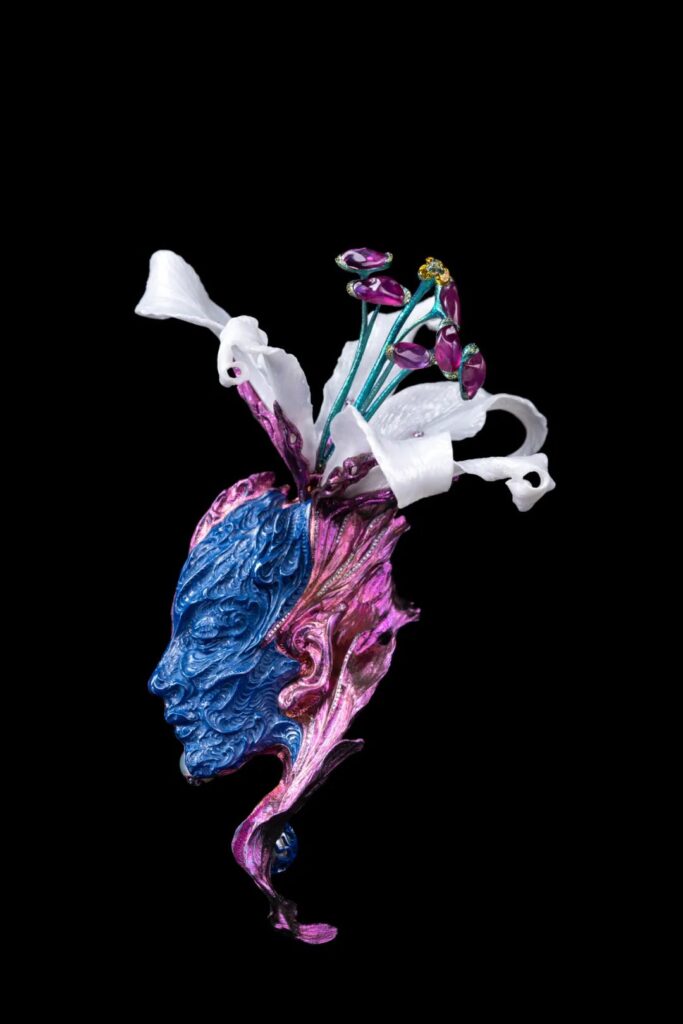
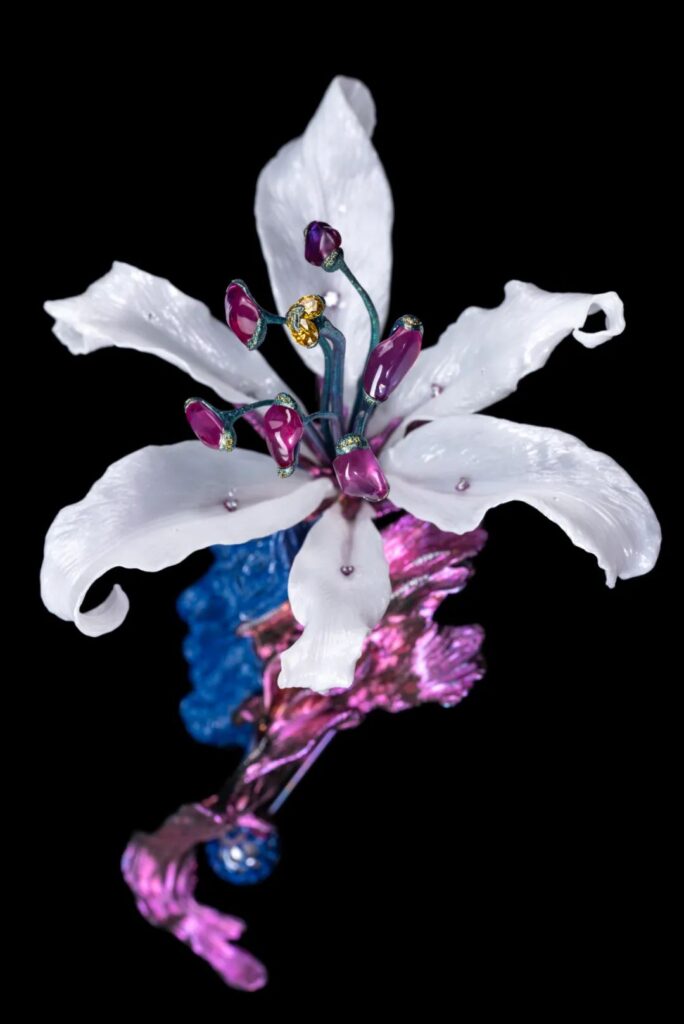
Six rubies totaling 12.90 carats,
Colored diamonds, diamonds, South Sea pearls, titanium, Wallace Chan Porcelain
Hi: How much weight does carving technique hold in your creations? How do you view the place of “craftsmanship” in artistic creation?
Chan: There’s endless discussion about carving. Just talking about the technical aspects of carving mediums – wood, ivory, ruby, sapphire… all carriers have different personalities. One must be intimately familiar with them to carve on them because once carved away, it can’t be undone.
When I forget about tools and materials, and use sound and touch to dialogue with the medium, it’s a dialogue of consciousness that lets me know the force needed when carving. This is a cognition that can only be achieved through experience.
Hi: How do you view the various gemstones and metal materials used in your creations? It’s said that all things have spirits. How do you maximize the properties of materials?
Chan: What are material properties? In the simplest terms, from a physics perspective, material properties are physical characteristics.
or example, we all know that diamonds are indestructible, but diamond rough can be cleaved; jadeite, although it has a hardness of about 6.5 to 7, is very brittle and shatters when dropped; white jade is soft but sticky to the knife, making it very difficult to carve… The basic physical properties of various stones can be easily looked up online today.
But this knowledge, which is now at our fingertips, could only be gained through experience in the past.
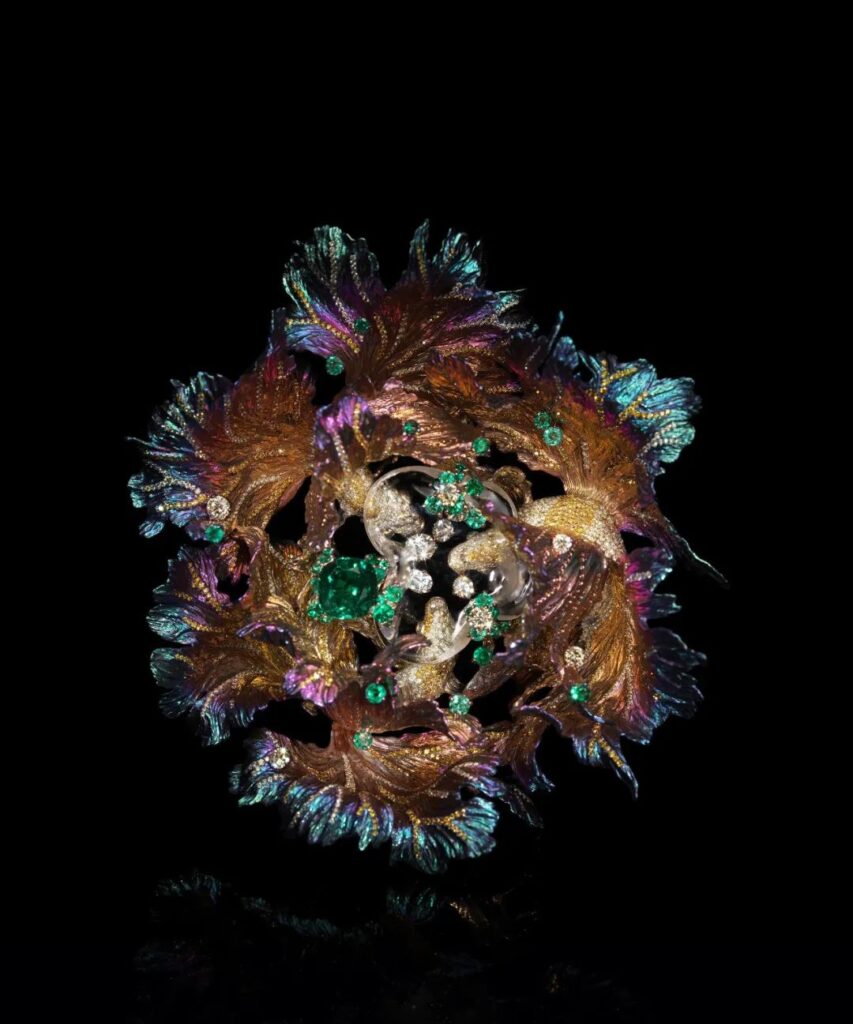
Emerald, yellow diamond, crystal, opal, titanium
Created by Wallace Chan
To perceive the true nature of a material, one needs vision, smell, touch, and hearing. I listen – during carving, the sound between the carving tool and the gemstone tells me whether to speed up or slow down, to stop or continue.
A 36,000 rpm drill bit can cause cracks in the gemstone, so carving often has to be done underwater. The eyes can’t see, so it relies on consciousness, requiring constant adjustment of the relationship between oneself and the object.
All things in the universe are living. A stone or a piece of metal may have a life frequency different from ours, but they might also breathe, perhaps taking hundreds of years for one inhalation and exhalation, which we can’t perceive. I learn to communicate with matter through love.
If you believe that objects are alive, you’ll know that material properties are not static or passive, but dynamic and active. You’ll also discover that material properties are spiritual properties, and all things have spirit.
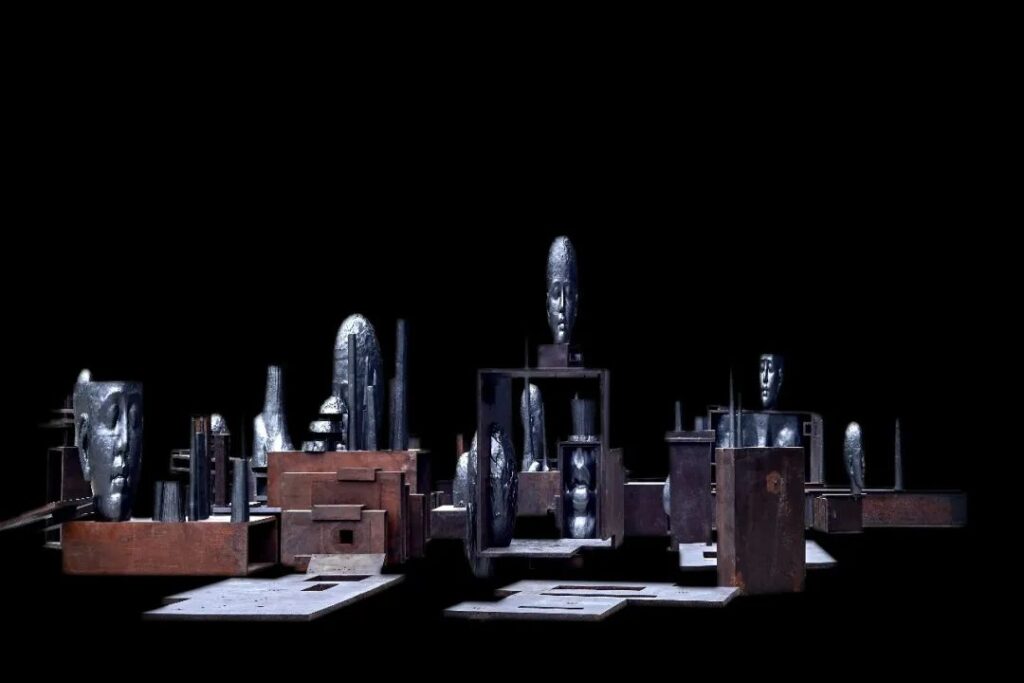
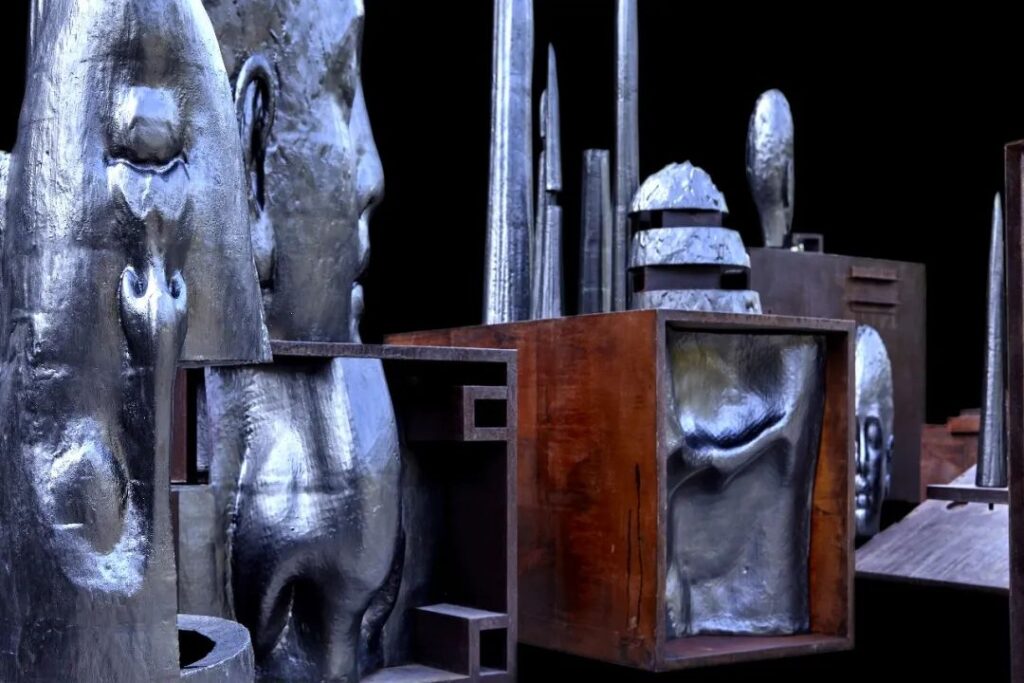
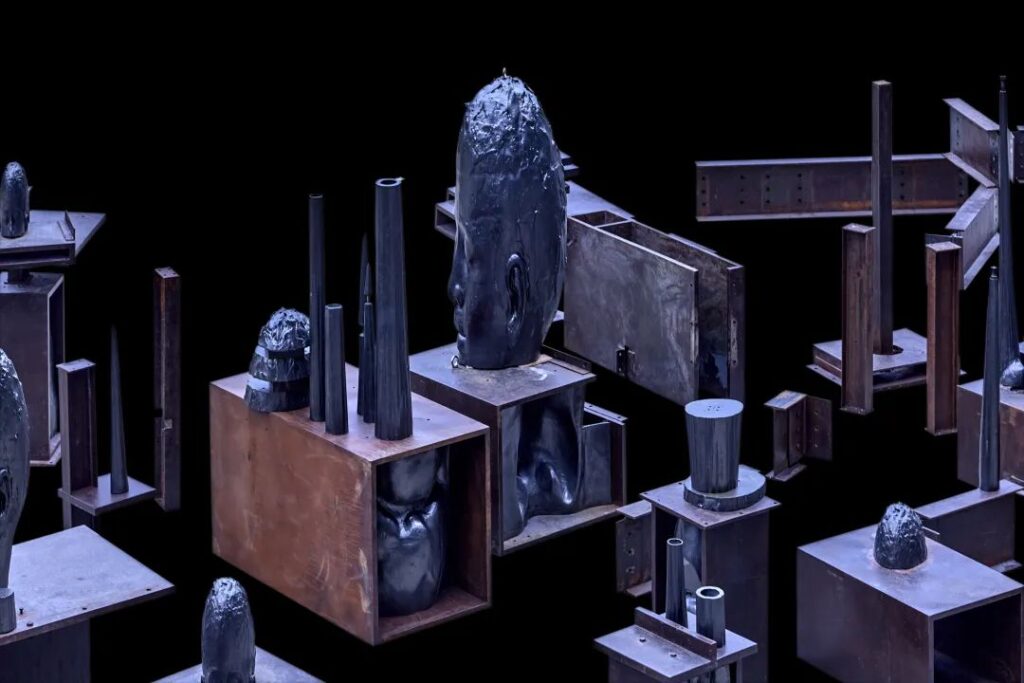
930 kg 2021 © Wallace Chan
Hi: Many of your jewelry pieces feature butterfly imagery. What special meaning does this hold for you?
Chan: Creations related to butterflies are numerous. The initial idea was simple: butterflies are too beautiful, and it’s a pity when they pass away. Even as specimens, they lack vitality. On the other hand, gemstones are eternal. Gemstones, full of texture and light colors, have infinite vitality. If butterfly specimens could be transformed into jewelry, butterflies could achieve immortality.
To preserve this fleeting beauty, I spent three years, experiencing countless moments on the edge of success and failure, before finally succeeding in embedding butterfly specimens between crystal and mother-of-pearl.

Emerald, diamond, ruby, amethyst, citrine,
blue topaz, crystal, butterfly specimen, mother-of-pearl, tsavorite,
sapphire, yellow diamond, 18K white gold, titanium
Created by Wallace Chan
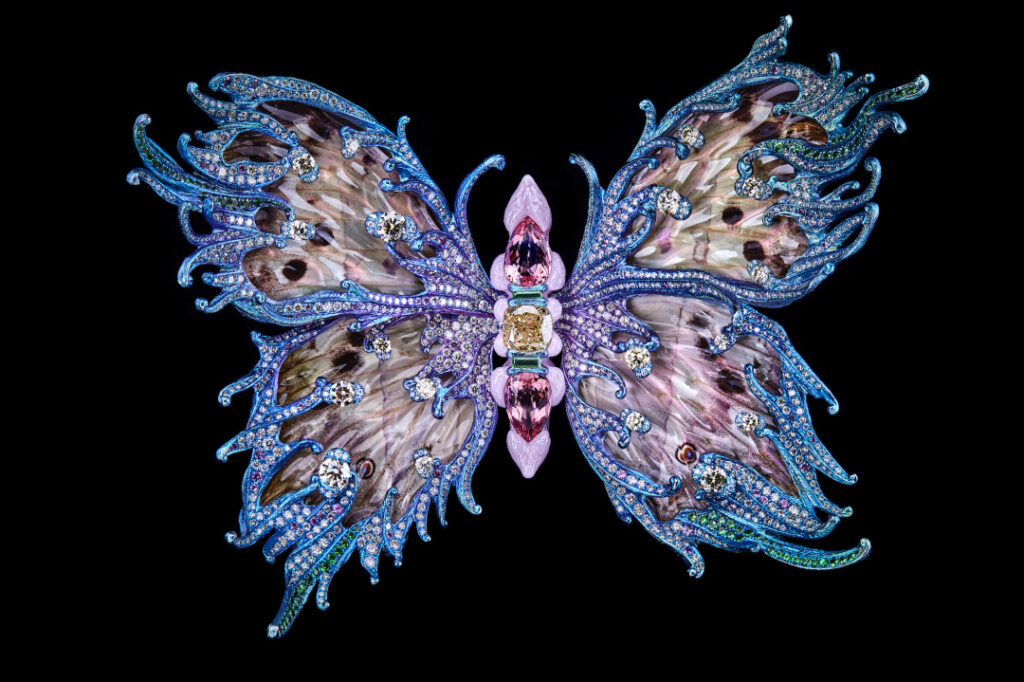
Yellow diamond, morganite, tsavorite, crystal, butterfly specimen, mother-of-pearl,
colored diamonds, diamond, pink corundum, Wallace Chan Porcelain, titanium
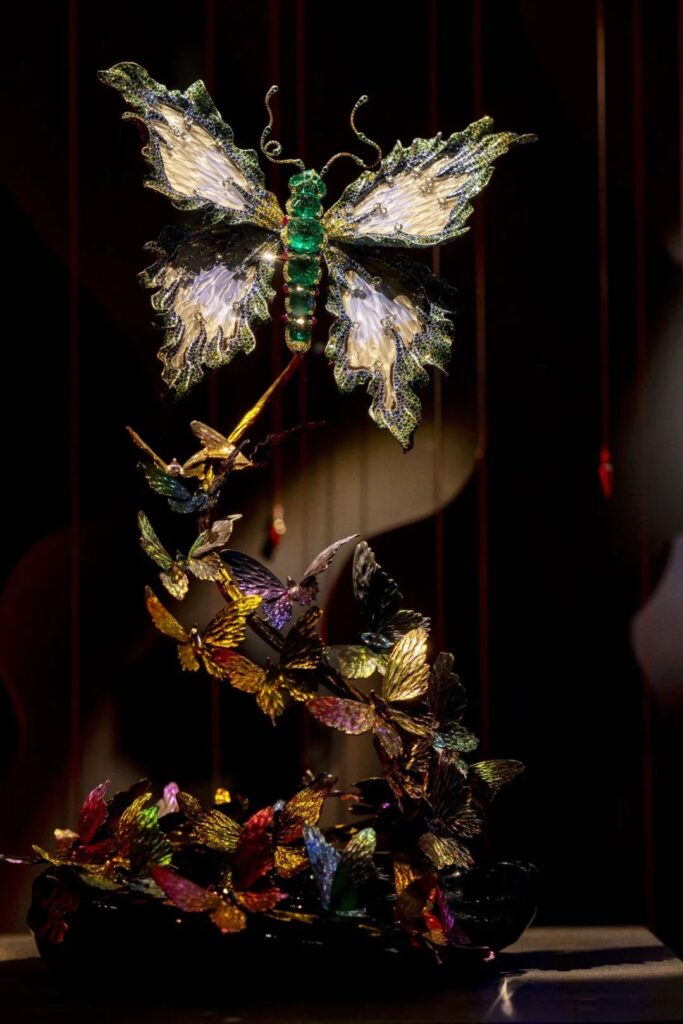
Shanghai Museum (East Wing), 2024 © Wallace Chan Studio
The butterfly is a theme of infinite resurrection. I review and re-review butterflies, always getting lost in a dreamlike world. Besides the well-known story of Zhuangzi’s butterfly dream that never ceases to fascinate me, I’m also grateful for technology that allows us to know there are wonders beyond our world.
The Butterfly Nebula, 4000 light-years away from us in the universe, has also contributed to the stories and meanings in my works. It can be said that through audacious creation, I have entered the world of reclusive practice.
I imagine that 300 or 400 years from now, perhaps other intelligent life forms will discover the existence of my works, obtaining evidence of our lives and understanding our past and present lives. In my eyes, the works are carriers of life and life itself.
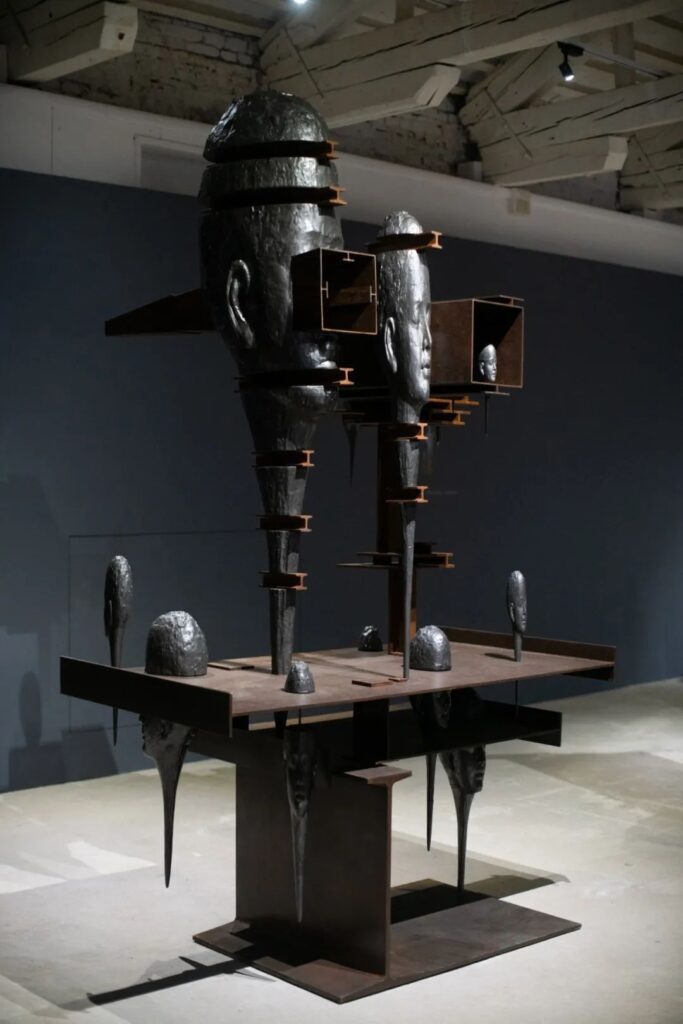
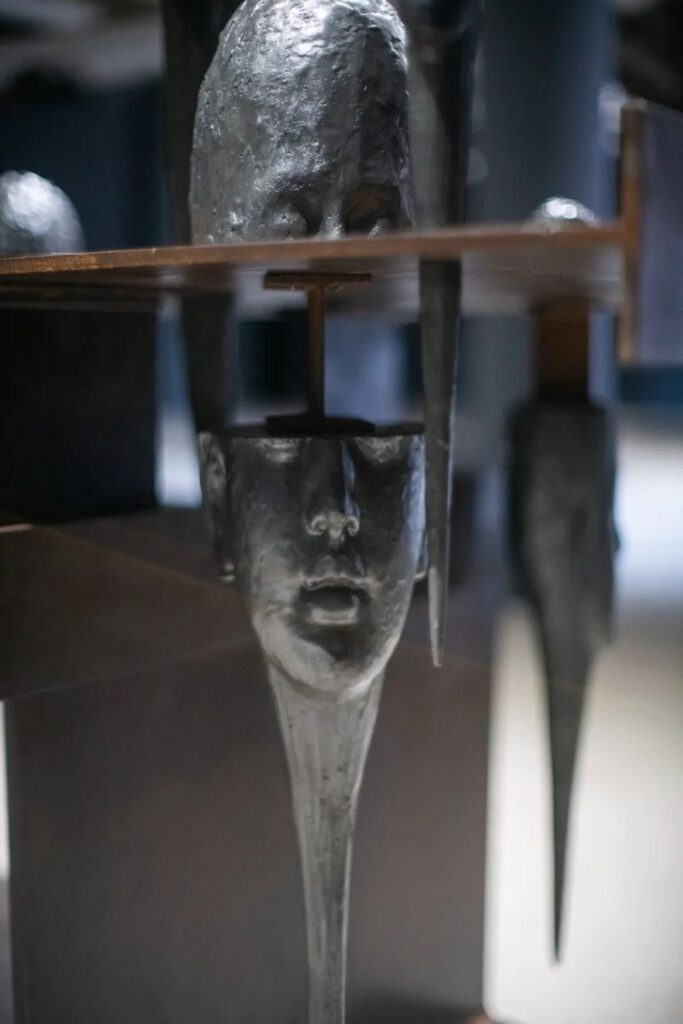
Fondaco Marcello, Venice, 2021,
Photography: Giacomo Cosua
Hi: What role does religion play in your creations?
Chan: I’ve been exposed to different religions since childhood – I’ve read the Bible in church, studied Buddhist scriptures, and experienced long-term spiritual practice. It seems I’ve been navigating between religions all my life. But I also don’t have a religious faith. Different beliefs converge in me through great love, transcending the self.
All religions are philosophies to me, just like art, they are spiritual pursuits. Creation is a spiritual realm that transcends from the tangible to the intangible, consistent with the concept of transcending time and space to achieve eternity in many religious beliefs.
At the end of the small chapel in this Venice exhibition, you’ll see an altar with two small sculptures placed on it – Buddha and Christ who have exchanged bodies. This is my tangible expression of so-called “transcendence”.
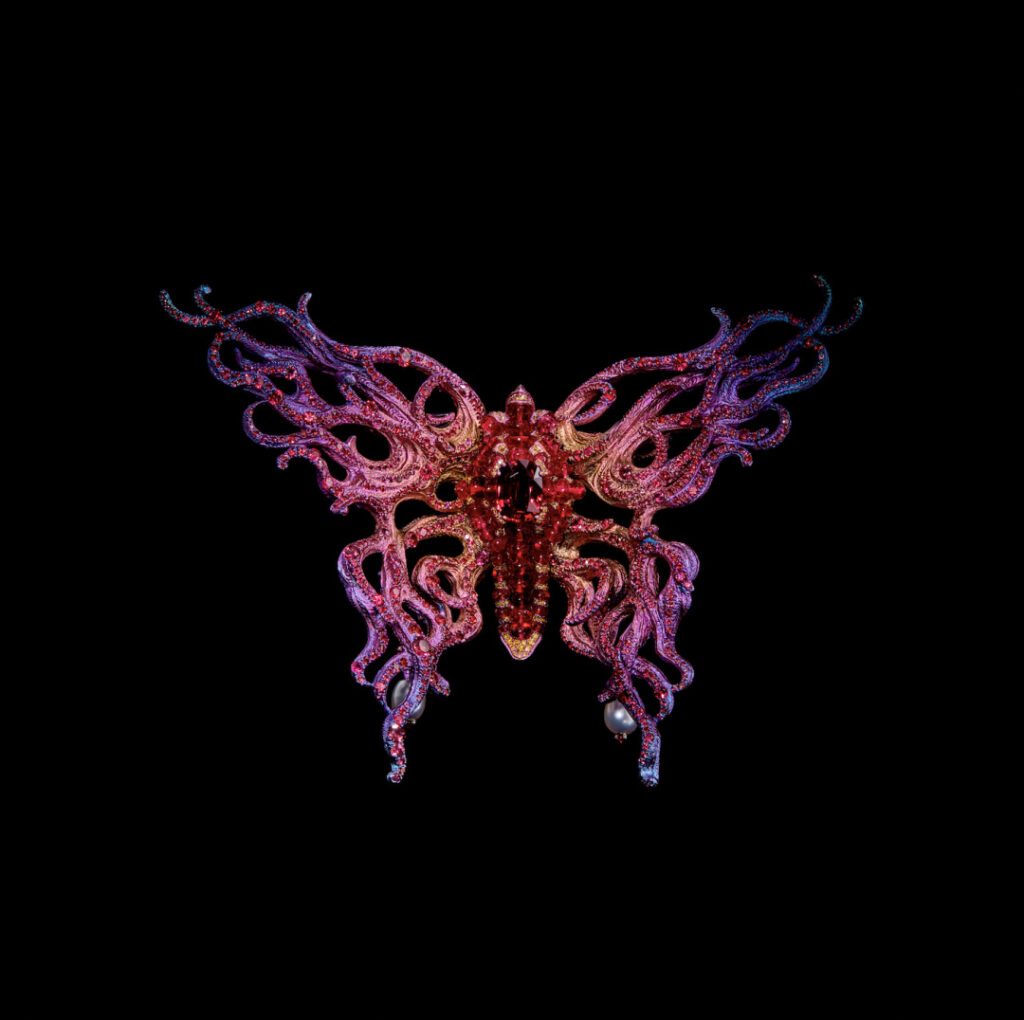
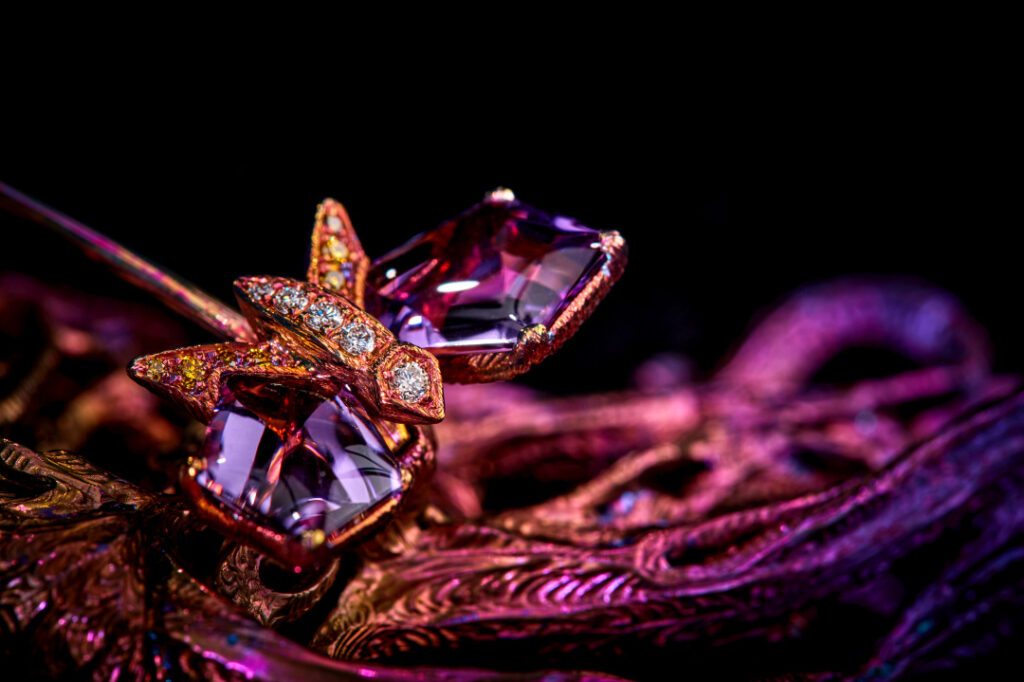
Red spinel, pearl, amethyst, yellow diamond, diamond, titanium
Hi: How do you define your identity? Jewelry designer or artist?
Chan: I’ve never deliberately thought about it. When I’m creating jewelry, I’m a jewelry artist; when I’m creating sculptures, I’m a sculptor. These definitions are meaningless in the world of creation. I’m just someone who loves to create, creating whatever comes to mind. I believe that cross-disciplinary practice is beneficial for thinking.
Different creations are like a self-complementary ecosystem, nourishing each other. The more mediums, knowledge, cultures, and techniques a creator masters, the greater their creative freedom.
Hi: Within less than three months, you held two different types of exhibitions in Venice and Shanghai. What kind of feedback do you hope to receive?
Chan: I hope that “A Dialogue Across Time” at the Shanghai Museum will show the audience that jewelry creation can also rise to the level of metaphysical art, bringing a more spiritual and conceptual feeling to the audience.
The “Transcendence” exhibition in Venice, presented in a small chapel, aims to bring the audience into a meditative state. Conflicts can be transformed into growth and enlightenment, allowing the mind to transcend the limits of space and time.

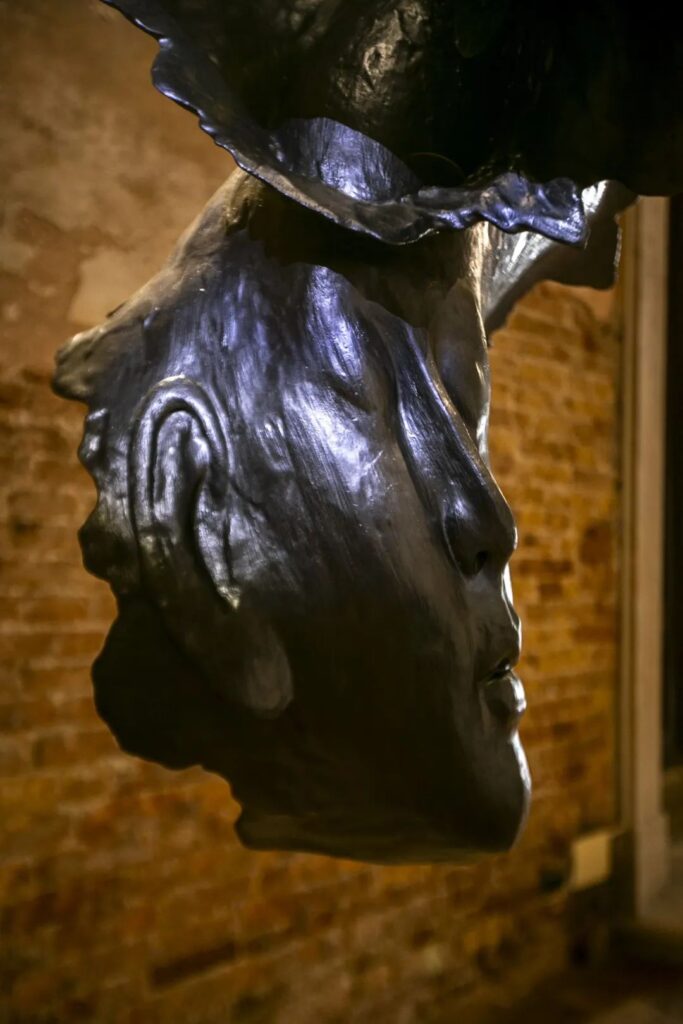
Santa Maria della Pietà, Venice, 2024 © Federico Sutera
Hi: What drives you to maintain innovation and a state of transcendence?
Chan: Creation for me is life, it’s like breathing. We don’t stop and ask: why do we breathe? Why does this inhalation and exhalation come so naturally? Creation is the meaning of my existence. Without creation, there’s no life. Only through continuous creation do I truly feel at ease.
Perhaps it’s because since childhood, I’ve only found the sense of belonging and feeling of home that I lacked in reality in the world of imagination. You could say that creation is like coming home.
Innovation is part of creation. Creation needs the support of tools, materials, methods, and so on. Creation comes from within, so innovation is necessary, an essential element in the creative process.
Wallace Chan: The Unrivaled Maestro of Chinese Jewelry Art
Tweet
